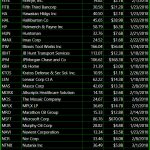Stewart Myers of MIT coined the term “growth options” to refer to future projects a company has the opportunity to undertake. Because the projects have not yet been undertaken, and in some cases may not yet be envisioned, the market valuation of growth options is prone to large swings. It depends on the perceptions of investors regarding what a company might be able to profitably do in the future. And those perceptions are likely to be mercurial because they are, by necessity, based on speculation regarding future businesses rather than the performance of actual businesses. Investor perceptions regarding the growth options of Tesla have been the reason that I have been wrong about Tesla’s stock price this year.
I thought it was overvalued at $300 because I did not see many growth options in the competitive automobile industry. There were enough investors that disagreed with me to drive the price over $380.

PublicDomainPictures/Pixabay
What makes investing in companies whose value is derived in large part from growth options so risky is that perceptions can change much more rapidly than the economics of operating businesses. If perceptions do change, the market valuation of growth options can disappear virtually overnight. Again Tesla is an example. In a week, it has dropped from over $380 to about $335. (I still expect it to fall below $300). Of course, perceptions can change again if Mr. Musk makes some dramatic announcements. Such volatility is likely to continue until Tesla matures to the point where more of its value is based on actual operations.














Leave A Comment